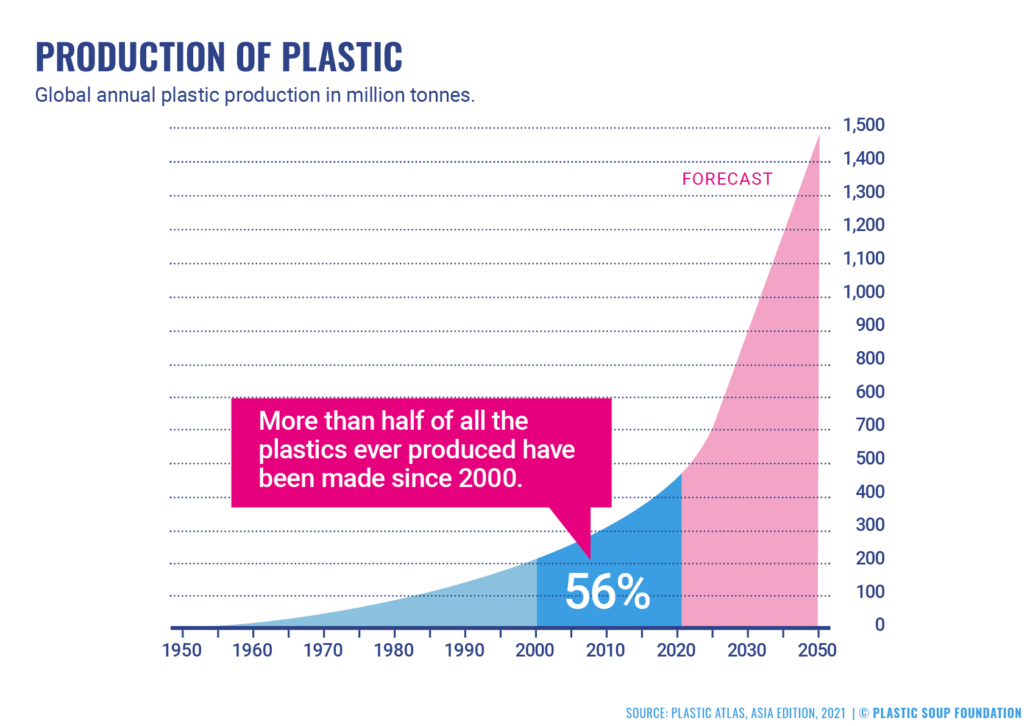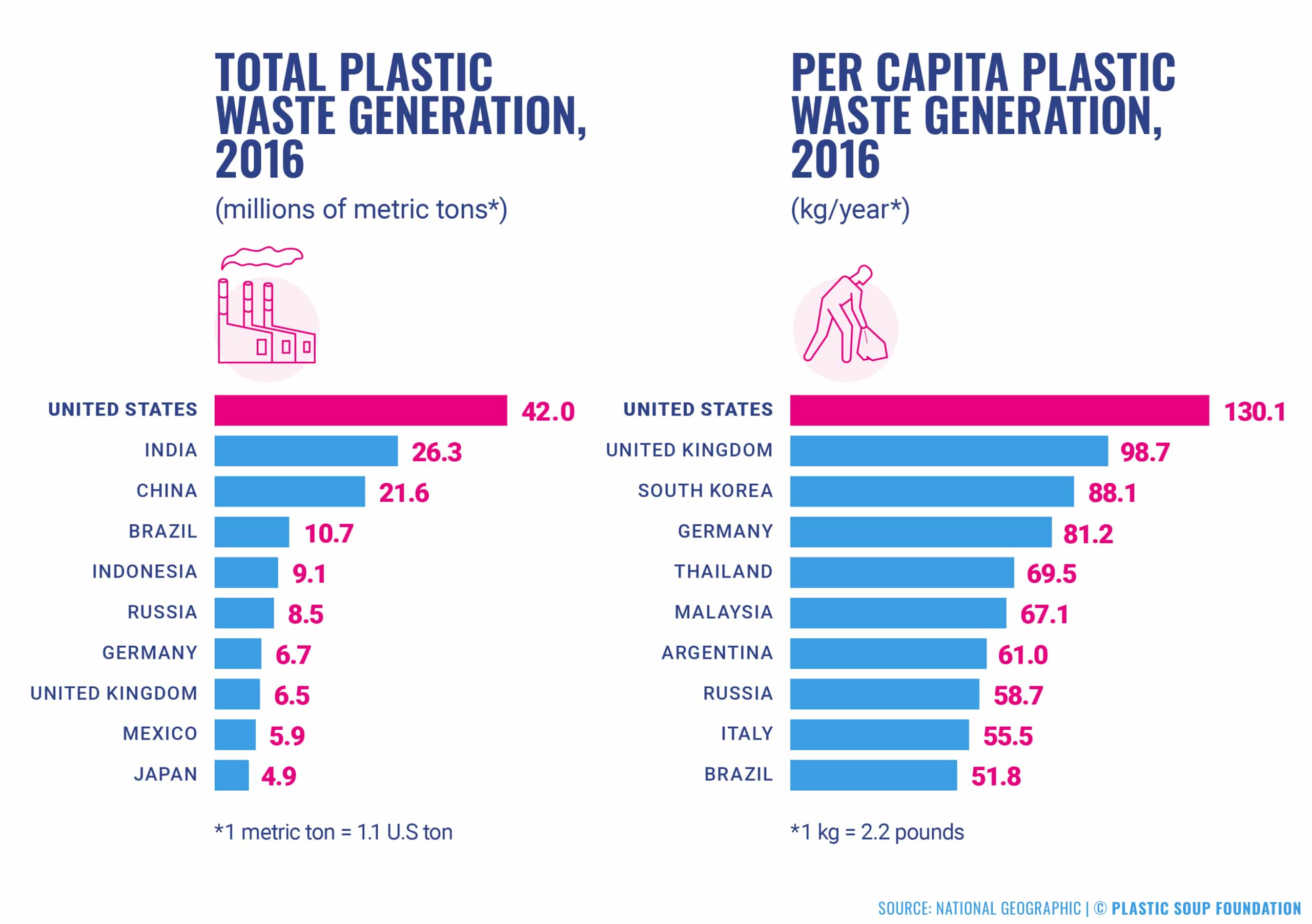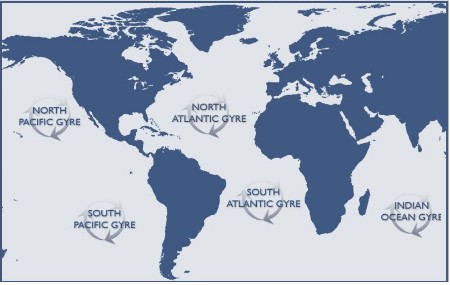Plastic Pollution
2023 APR 7
Mains >
Environment & Ecology > Pollution > Plastic pollution

WHY IN NEWS?
- An estimated 170 trillion plastic particles weighing about 2 million metric tons are currently afloat in the oceans across the world, according to a new study, which added that if no urgent action is taken then this number could nearly triple by 2040.
BACKGROUND:
- Plastic pollution is the accumulation of plastic objects and particles (ex: plastic bottles, bags and microbeads) in the environment that adversely affects humans, wildlife and their habitat.
- Today, the world produces about 400 million tonnes of plastic waste every year.

STATISTICS:
- Globally
- Between the 1950s and 2017, an estimated 9.2 billion tons of plastic have been manufactured, of which an estimated 9% has been recycled and another 12% has been incinerated.
- India:
- According to the report titled 'Plastics, The Potential and Possibilities', India generates around 3.4 million tonnes (MT) of plastic waste in a year, of which only 30% is recycled.
- According to FICCI, an Indian consumes 11 kg of plastic per year.
- India’s contribution is around 3.1% of the global plastic waste generation.

CAUSES:
- Rising consumption:
- Plastic is cheap and durable, which make it ideal to meet the demands of the rising population. However, most of it is single-use plastic.
- Slow rate of decomposition:
- The decomposition rate of plastic typically ranges from 400 to 600 years, depending on the type. Hence, they remain in the environment for long.
- Poor waste management:
- Disposal of plastic is often mismanaged. It ends up in landfills and waterbodies or being burned.
- Also, Countries importing the waste plastics often lack the capacity to process all the material.
- Informal sector activity:
- Plastic waste collection in developing countries like India is dominated by the informal sector workers. They lack the knowledge and the resources to segregate and scientifically dispose plastic waste.
- Infrastructure deficit:
- The number of recycling and collection facilities in India are dismal compared to the amount of plastic waste being generated in India.
- Ineffective enforcement:
- The current framework continues to ignore the informal sector. Also, there is no independent mechanism to verify the implementation of measures such as Extended Producer Responsibility (EPR).
- Pandemic:
- COVID-19 saw an increase in plastic finding its ways to the ocean, especially from medical waste and masks.
EFFECTS OF PLASTIC POLLUTION
- Environmental impact:
- Plastics including microplastics are now part of the Earth's fossil record and a marker of the Anthropocene. They have even given their name to a new marine microbial habitat called the "plastisphere".
- Negative effects on human health:
- Microplastics enter the human body and lead to an array of health impacts.

- Marine pollution:
- An estimated 170 trillion plastic particles weighing about 2 million metric tons are currently afloat in the oceans across the world.
- The most noted among these is the Great Pacific Garbage Patch—a 600-sq km floating island of plastic waste in the North Pacific Ocean.

-
- Impact on marine life:
- Marine wildlife such as seabirds, whales, fishes and turtles, mistake plastic waste for prey, and most die of starvation, ingestion, suffocation and entanglement in plastics.
- Plastic-contaminated seafood:
- Scientists have found micro plastics in 114 marine species, and around one-third of these end up on our plates.
- Upsets the marine food Chain:
- Because it comes in sizes large and small, polluting plastics are found in even the world’s tiniest organisms, such as plankton.
- Water pollution:
- Toxic chemicals from plastics drain out and seep into groundwater, flowing downstream into lakes and rivers.
- A 2017 study found that 83% of tap water samples taken around the world contained plastic pollutants.
- Soil pollution:
- When plastic is dumped in landfills, it interacts with water and forms hazardous chemicals. The leaching causes soil pollution.
- Air pollution:
- Burning of plastics leads to the release of poisonous chemicals. The polluted air, when inhaled, affects the health and can cause respiratory problems.
- Economic impacts:
- Plastic pollution costs USD 13 billion in economic damage to marine ecosystems per year. This includes losses to the fishing industry and tourism, as well as the cost to clean up beaches.
- Invasive Species:
- Plastic waste can also be a mode of transport for species, potentially increasing the range of certain marine organisms or introducing species into an environment where they were previously absent.
- Floods:
- Plastic waste can clog storm drains, and such clogging can increase flood damage, particularly in urban areas.
- For example: in Bangkok flood risk increases substantially because of plastic waste clogging the already overburdened sewer system
PLASTIC WASTE MANAGEMENT IN INDIA:
- Plastic Waste Management Rules 2016:
- It replaced the 2011 Rules. It gave emphasis on a complete ban on plastics below 50 microns, phasing out use of multi-layered packaging and introduced Extended Producer Responsibility (EPR).
- Increase minimum thickness of plastic carry bags from 40 to 50 microns and stipulate minimum thickness of 50 micron for plastic sheets.
- Pre-registration of the producers, importers and vendors of plastic carry bags
- Promote use of plastic waste for road construction
- Plastic Waste Management (Amendment) Rules, 2021:
- The 2021 Rules amend the Plastic Waste Management Rules, 2016. Key amendments include:
- Ban on plastic items:
- The 2021 Rules impose a ban on the manufacture, sale and use of certain single-use plastic items across the country from July 1, 2022.
- Thickness of carry bags:
- The 2021 Rules increase the minimum thickness of bags to 75 microns with effect from September 30, 2021.
- This was further increased to 120 microns from December 31, 2022.
- ‘Prakriti’:
- In another step toward eliminating single-use plastic, the Union Environment Ministry launched “Prakriti”, a mascot to spread greater awareness about small changes that can be sustainably adopted in the lifestyle for a better environment.
- National Dashboard on Elimination of Single Use Plastic and Plastic Waste Management (MoEFCC):
- This aims to connect all stakeholders including Central Ministries/ Departments, State/UT Governments, etc. through one platform and track status and progress made for elimination of single use plastic & effective management of plastic waste.
- Extended Producer Responsibility (EPR) Portal for Plastic Packaging (CPCB):
- This portal will look after tasks that will help in overall operational functions like improving accountability, traceability, transparency and facilitating ease of reporting compliance to EPR Obligations by Producers, Importers and Brand-owners.
- Mobile App for Single Use Plastics Grievance Redressal (CPCB):
- This app will allow citizens to check sale/usage/manufacturing of single use plastic in their region and tackle the plastic menace.
- Monitoring module for single use plastic (CPCB):
- This will be for local bodies, State pollution control board/PCCs and CPCB, etc. to invent details of single use plastic production, its sale & usage, etc. in commercial establishments at district level, and on-ground enforcement of ban on single use plastics.
- Industrial production of Graphene from Waste Plastic (G B Pant NIHE & NRDC):
- To promote more industries to come forward to upcycle plastic waste.
- India Plastics Pact:
- It is a collaborative initiative that aims to bring together businesses, governments and NGOs across the whole value chain to set time-bound commitments to reduce plastics from their value chains.
- Swachh Bharat Mission.
- Waste management infrastructure in the States/UTs is being strengthened through the Swachh Bharat Mission.
- Other campaigns:
- India Plastic Challenge – Hackathon 2021: It was to encourage innovation in development of alternatives to identified single use plastic items and digital solutions to plastic waste management.
- Ministry of Environment, Forest, and Climate Change launched two-month long awareness campaign in 2021 for awareness generation towards elimination of single use plastics.
CHALLENGES IN PLASTIC WASTE MANAGEMENT:
- Volume of waste generated:
- With rapid urbanisation, rising population and increasing dependence on plastics, the amount of waste generated far exceeds the management capabilities.
- Absence of segregation:
- Due to the absence of waste segregation at source into biodegradable and non-biodegradable, considerable amount of plastic waste is not recycled, leading to it being incinerated or dumped in landfills.
- Fewer alternatives:
- Ban on plastics have had limited success due to absence of alternatives.
- Ex: Bioplastic production in India is just 1% out of 300 million tonnes of conventional plastics produced annually.
- Informal waste management sector:
- Waste collection and processing in India is carried out largely by the informal sector. This makes it difficult to implement the waste management rules, ensure scientific disposal of wastes and address the welfare of workers.
- Lack of awareness:
- People lack proper awareness regarding the threats posed by plastics or the need of better waste disposal for their health and wellbeing.
- Weak enforcement:
- 22 States have, in the past, announced a ban on single-use plastic. But this has had little impact on the crisis because governments were half-hearted in their approach and alternatives were not made available on time.
- Unempowered local government bodies:
- Due to lack of funds and technical expertise, local governments rely on burning plastic wastes or on municipal contracts, where companies are paid for haulage of mixed waste.
- Absence of community participation:
- Due to lack of incentivisation and awareness, participation from non-profits or community is limited.
- Also, most of the rules encourage centralized treatment such as waste to energy, which is still under-developed in the country.
- Unbalanced spending:
- Three-fourth of solid waste management budget is allotted to collection and transportation, which leaves very little for processing or resource recovery and disposal.
- Rise of E-Commerce industry:
- The popularity of online retail and food delivery apps, though restricted to big cities, is contributing to the rise in plastic waste.
WAY FORWARD
- The 3R’s +E Strategy:
- Reduce: To efficiently reduce plastic pollution, there is an evident need of reducing our usage of plastic.
- Reuse: Many plastic items can be reused or used for different purposes. Before throwing plastic items, it is important to consider how they can be reused.
- Recycle: Plastic recycling consists of collecting plastic waste and reprocessing it into new products, to reduce the amount of plastic in the waste stream.
- Educate: Another crucial solution is education in order to increase awareness and behavioural change.
- Decentralise waste management:
- Civic bodies have to redraw long term vision in solid waste management and rework their strategies as per changing lifestyles.
- They should reinvent garbage management in cities so as to process waste and not landfill it.
- Segregation at source:
- The key to efficient waste management is to ensure proper segregation of waste at source and to ensure that the waste goes through different streams of recycling and resource recovery.
- Promote alternatives to plastics:
- Alternatives such as biodegradable plastics, geotextiles and waste-to-energy plants are crucial for solid waste management.
- Formalise the sector:
- Waste collection and processing should be developed into a formal, technology-reliant sector.
- Start-ups and PPP models need to be encouraged in the sector.
- Incentivise the business:
- Government should provide viability gap funding for waste processing infrastructure projects to make in financially viable.
- It may also look into incentivising people for proper waste segregation and using recycled products.
- Promote awareness:
- Managing plastic waste requires effective knowledge, not only among those who produce the plastic, but also among those who handle it.
- International cooperation:
- The international view is changing and support for a ‘Plastic Treaty’ is growing.
- India should take the lead role and push for an international agreement on regulating plastic and plastic wastes.
- Government supported R and D:
- Government must provide subsidy for research and development activity for substitute development, appropriate disposal mechanisms and waste management and use of waste for constructive usage like roads.
- Taxing plastic use:
- Government should reform existing taxes and subsidies that have a negative environmental impact, taking into account the different types or grades of plastics, and restructuring existing taxes in an environmentally friendly manner.
BEST PRACTICE
- Rwanda’s ban on plastics:
- Since 2008, the African country banned the import, manufacture and distribution of plastic, with a few exceptions.
- Backed by strong political will by the government, Municipalities are responsible for enforcement of the ban.
- On the last Saturday of every month, from 8 to 11 am, people across the country gather to clean their neighbourhoods.
- Every school in Rwanda has an “environment club”, where trained teachers inculcate messages of cleanliness to students and through them to their parents.
- Violation of the ban or non-participation in community work can invite jail time or a fine.
- The ban has helped the country’s economy, as Rwanda has seen an increase in tourism due to its cleanliness.
PRACTICE QUESTION:
Q. Discuss the threats posed by plastic pollution. What measures have the government taken to address it




